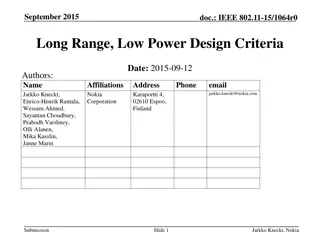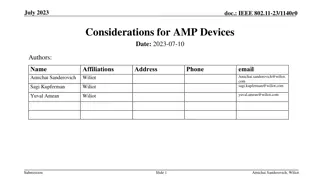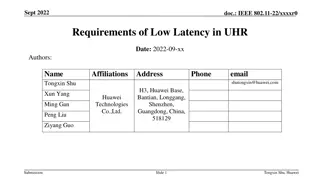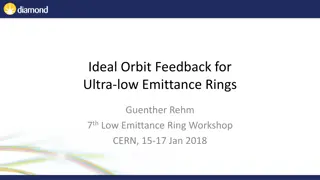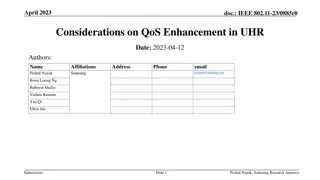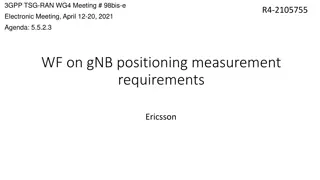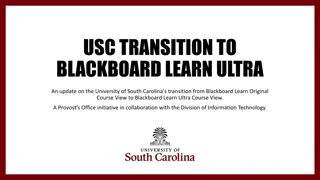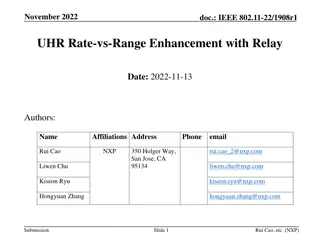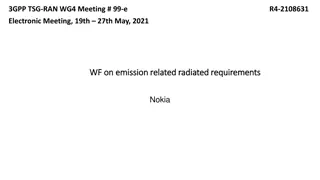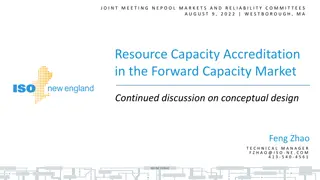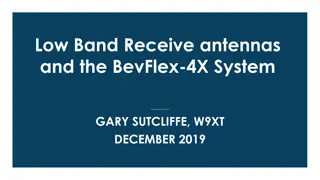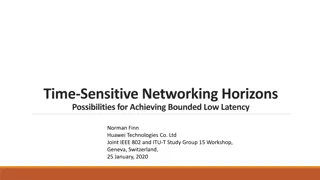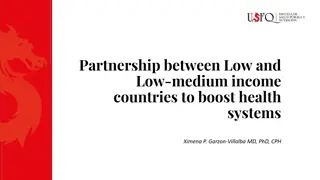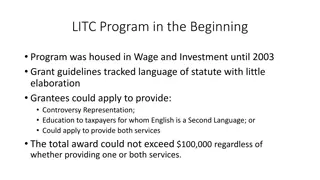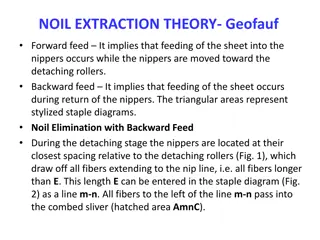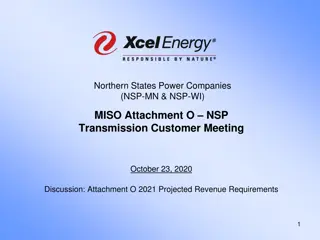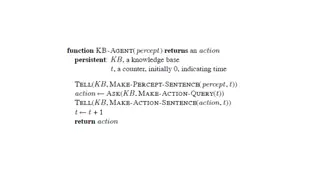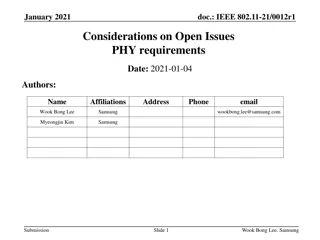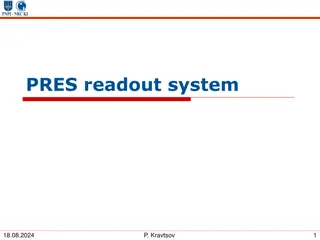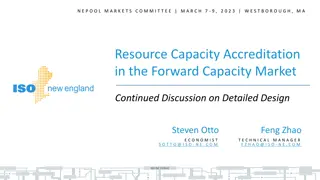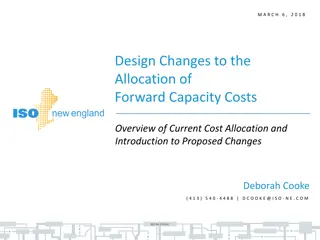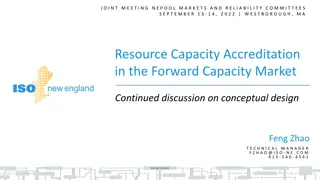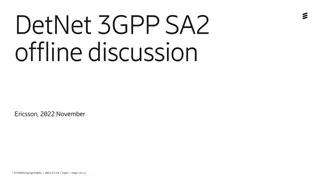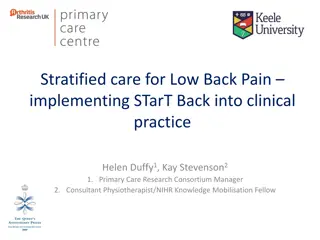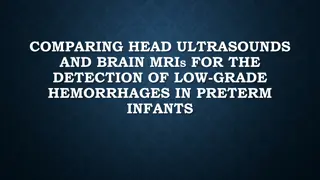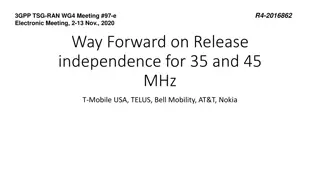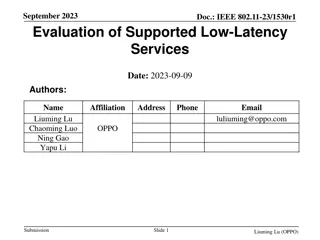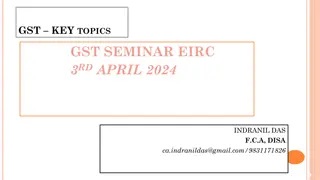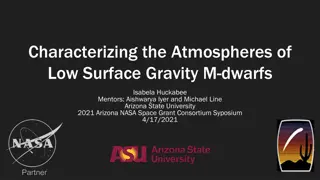Way Forward on Ultra-Low BLER Requirements and Open Issues Discussion
Discussions have been held regarding ultra-low BLER requirements for UE and BS, with agreements reached in the first and second rounds. Extra margin considerations and test requirements were emphasized, along with proposals for CQI reporting and FR2 requirements. Open issues include CQI requirements and test applicability rules, with various proposals for consideration. The focus is on further analysis and decision-making for a comprehensive approach to meeting the specified requirements.
Download Presentation

Please find below an Image/Link to download the presentation.
The content on the website is provided AS IS for your information and personal use only. It may not be sold, licensed, or shared on other websites without obtaining consent from the author. Download presentation by click this link. If you encounter any issues during the download, it is possible that the publisher has removed the file from their server.
E N D
Presentation Transcript
Way Forward on ultra-low BLER requirements R4-2008805 Moderator (Ericsson)
Agreements in first round For the UE, MCS 14 is agreed For the UE, antenna assumption is changed to 1x2, 1x4 UE applicability agreement: Requirements are applicable for UEs that support both MCS Table 3 (dl-64QAM-MCS-TableAlt) and CQI Table 3 (cqi- TableAlt). BS TDD pattern: 3D1S1U (S=10:2:2) for 15kHz, 7D1S2U (S=6:4:4) for 30kHz X is confirmed as 0.5dB for the UE and 1dB for the BS For the BS, the test applicability rule means that either typeA mapping or typeB mapping is tested (depending on declaration) but not both.
Agreements in second round How to capture X in the UE specifications: X is captured in the RAN5 specification. Extra Margin EM needed to ensure that the RAN4 requirement is suitable to achieve 10^-5 is discussed and captured implicitly in the core specification as usual in RAN4. How to capture in the BS specifications: Capture in the conformance specification by adding 1dB to test requirement and documenting as below. Extra Margin EM needed to ensure that the RAN4 requirement is suitable to achieve 10^-5 is discussed and captured implicitly in the core specification as usual in RAN4. Test Minimum Requirement in TS 38.104 [2] Test Tolerance (TT) Test requirement in the present document 8.2.X reliability Performance requirements for PUSCH high SNRs as specified 0.6 dB Formula: SNR + TT + 1dB PUSCH false detection limit unchanged
Agreements in the second round Number of UE test cases for the FMCS requirement: 4 (FDD/2RX, FDD/4RX, TDD/2RX, TDD/4RX) For UE, both TDD and FDD are tested with maximum supported RX
Open issues CQI requirement Proposals Option 1: No CQI requirement (Intel, Huawei, Apple) Option 2: CQI requirement with median CQI and BLER with higher/lower CQI followed, together with test applicability rule on CQI/FMCS (Qualcomm) Recommended WF -> Keep it open, further check test feasibility for CQI reporting and make decision in Q3 2020. -> If RAN4 can concluded test time is comparable to FMCS test cases, then RAN4 decide to introduce static CQI test case with ultra- low BLER -> FFS whether we need to introduce test applicable rules among CQI/FMCS test cases if CQI test cases introduced -> Companies also encourage to bring analysis whether static CQI/fading CQI test with non-ultra-BLER can serve test purpose FR2 requirements Proposals Option 1: FR2 requirements (DoCoMo) Option 2: No FR2 requirements (Apple, Qualcomm, Ericsson, Huawei, Samsung) Option 3: Defer decision to next meeting (Intel, DoCoMo) Recommended WF
Open issues Test applicability rule for FMCS and CQI Only applicable if CQI test is introduced Proposals Option 1: Introduce applicability rule (Qualcomm) Option 2: No rule; both tested (Huawei) Recommended WF BS SCS test applicability Proposals Option 1: All supported SCS tested (Ericsson, Intel, DoCoMo) Option 2: Only 15kHz SCS tested if both supported (Ericsson, Nokia) Option 3: Only 30kHz SCS tested if both supported (Ericsson, Nokia, Intel, Huawei) Recommended WF
Agreed simulation assumptions (UE) Parameter Value Frequency range FR1 Transform precoding Disabled Duplex mode FDD/TDD 1x2, ULA low 1x4, ULA low Antenna configuration Mapping type Type A Starting symbol (S) 2 PDSCH configuration Length (L) 12 PUSCH aggregation factor 1 DMRS Type Type 1 Single-symbol DM-RS PDSCH DMRS configuration DM-RS duration Number of additional DMRS 1 Number of HARQ Transmissions 1 PT-RS Disabled Propagation condition AWGN MCS Table Table 3, MCS14 FDD:15KHz, 10MHz TDD:30KHz, 40MHz SCS and BW Frequency domain resource Full BW TDD pattern 7D1S2U (S=6:4:4) Target BLER: 10-5 Testing metric
Agreed simulation assumptions (BS) Parameter Value Frequency range FR1 Transform precoding Disabled Antenna configuration 1x2, ULA low Mapping type Type A and Type B Starting symbol (S) 0 PUSCH configuration Length (L) 14 PUSCH aggregation factor 1 DMRS Type Type 1 Single-symbol DM-RS PUSCH DMRS configuration DM-RS duration Number of additional DMRS 1 Number of HARQ Transmissions 1 PT-RS Disabled Propagation condition AWGN MCS Table Table 3, MCS 5 15 kHz for 10 MHz (see NOTE) 30 kHz for 40 MHz (See NOTE) SCS and BW Frequency domain resource Full Bandwidth 15 kHz SCS: 3D1S1U, S=10:2:2 30 kHz SCS: 7D1S2U, S=6:4:4 TDD pattern Target BLER: 10-5 Testing metric NOTE: It was previously agreed to follow the decision for slot aggregation regarding supported bandwidths. Thus if decided for slot aggregation, then 5MHz should be added for 15k SCS and 10MHz for 30k SCS. Other parameters will remain the same in these cases.
Agreements regarding testing X is 0.5dB for UE and 1dB for BS X is captured in the RAN5 specification for the UE and the conformance specification for the BS according to the agreements in slide 3. The RAN5 statistical test methodology is assumed, adapted for CL = 99.999%



